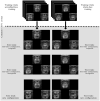A comparative study of face processing using scrambled faces
- PMID: 22896918
- PMCID: PMC4467555
- DOI: 10.1068/p7151
A comparative study of face processing using scrambled faces
Abstract
It is a widespread assumption that all primate species process faces in the same way because the species are closely related and they engage in similar social interactions. However, this approach ignores potentially interesting and informative differences that may exist between species. This paper describes a comparative study of holistic face processing. Twelve subjects (six chimpanzees Pan troglodytes and six rhesus monkeys Macaca mulatta) were trained to discriminate whole faces (faces with features in their canonical position) and feature-scrambled faces in two separate conditions. We found that both species tended to match the global configuration of features over local features, providing strong evidence of global precedence. In addition, we show that both species were better able to generalize from a learned configuration to an entirely novel configuration when they were first trained to match feature-scrambled faces compared to when they were trained with whole faces. This result implies that the subjects were able to access local information easier when facial features were presented in a scrambled configuration and is consistent with a holistic processing hypothesis. Interestingly, these data also suggest that, while holistic processing in chimpanzees is tuned to own-species faces, monkeys have a more general approach towards all faces. Thus, while these data confirm that both chimpanzees and rhesus monkeys process faces holistically, they also indicate that there are differences between the species that warrant further investigation.
Figures



Similar articles
-
Recognizing facial cues: individual discrimination by chimpanzees (Pan troglodytes) and rhesus monkeys (Macaca mulatta).J Comp Psychol. 2000 Mar;114(1):47-60. doi: 10.1037/0735-7036.114.1.47. J Comp Psychol. 2000. PMID: 10739311 Free PMC article.
-
Matching visual stimuli on the basis of global and local features by chimpanzees (Pan troglodytes) and rhesus monkeys (Macaca mulatta).Anim Cogn. 2002 Mar;5(1):27-31. doi: 10.1007/s10071-001-0121-8. Anim Cogn. 2002. PMID: 11957399 Free PMC article.
-
The composite face effect in chimpanzees (Pan troglodytes) and rhesus monkeys (Macaca mulatta).J Comp Psychol. 2012 Nov;126(4):339-46. doi: 10.1037/a0027287. Epub 2012 Mar 5. J Comp Psychol. 2012. PMID: 22390621 Free PMC article.
-
Geometric distortions affect face recognition in chimpanzees (Pan troglodytes) and monkeys (Macaca mulatta).Anim Cogn. 2011 Jan;14(1):35-43. doi: 10.1007/s10071-010-0341-x. Epub 2010 Jul 15. Anim Cogn. 2011. PMID: 20632050 Free PMC article.
-
The evolution of face processing in primates.Philos Trans R Soc Lond B Biol Sci. 2011 Jun 12;366(1571):1764-77. doi: 10.1098/rstb.2010.0358. Philos Trans R Soc Lond B Biol Sci. 2011. PMID: 21536559 Free PMC article. Review.
Cited by
-
Face cells encode object parts more than facial configuration of illusory faces.Nat Commun. 2024 Nov 14;15(1):9879. doi: 10.1038/s41467-024-54323-w. Nat Commun. 2024. PMID: 39543127 Free PMC article.
-
When the whole is only the parts: non-holistic object parts predominate face-cell responses to illusory faces.bioRxiv [Preprint]. 2023 Sep 22:2023.09.22.558887. doi: 10.1101/2023.09.22.558887. bioRxiv. 2023. Update in: Nat Commun. 2024 Nov 14;15(1):9879. doi: 10.1038/s41467-024-54323-w. PMID: 37790322 Free PMC article. Updated. Preprint.
-
Face Pareidolia in the Rhesus Monkey.Curr Biol. 2017 Aug 21;27(16):2505-2509.e2. doi: 10.1016/j.cub.2017.06.075. Epub 2017 Aug 10. Curr Biol. 2017. PMID: 28803877 Free PMC article.
-
Intranasal oxytocin selectively modulates the behavior of rhesus monkeys in an expression matching task.Sci Rep. 2019 Oct 23;9(1):15187. doi: 10.1038/s41598-019-51422-3. Sci Rep. 2019. PMID: 31645593 Free PMC article.
References
-
- Amici F, Aureh F, Call J. Fission – fusion dynamics, behavioural flexibility, and inhibitory control in primates. Current Biology. 2008;18:1415–1419. - PubMed
-
- Barrett L, Henzi SP, Dunbar RIM. Primate cognition: from ‘what now?’ to ‘what if?’. Trends in Cognitive Science. 2003;7:494–497. - PubMed
-
- Bernstein MJ, Young SG, Hugenberg K. The cross-category effect: Mere social categorization is sufficient to elicit an own-group bias in face recognition. Psychological Science. 2007;18:706–771. - PubMed
-
- Brainard DH. The Psychophysics Toolbox. Spatial Vision. 1997;10:433–436. - PubMed
-
- Bruce C. Face recognition by monkeys: Absence of an inversion effect. Neuropsychologia. 1982;20:515–521. - PubMed
Publication types
MeSH terms
Grants and funding
LinkOut - more resources
Full Text Sources

